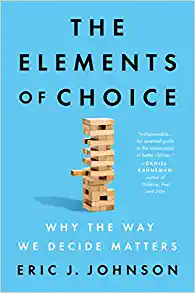Blog Content Writing is Choice Architecture
Choice architecture is not just about how websites are designed or how policies are implemented, Eric J. Johnson explains in the book The Elements of Choice. We are all designers every day he says, posing choices to our friends, colleagues, and families.
You think you’re choosing dinner from a restaurant menu, a fund for your retirement plan, or a movie to see with your spouse, but the decisions made by the restaurant, by your employer, or by your spouse about how to pose those choices to you influence what you end up choosing.
The author relates a fascinating experiment conducted by a professor named Irwin Levin of the University of Iowa. Two groups of undergrads were asked to rate samples of raw ground beef. One group was shown packages labeled 25% fat”, while the second group was shown packages labeled “75% lean”, with the second group reporting a more positive perception of the meat. Carrying the experiment even further, Levin and his team actually cooked the meet in front of the individuals involved in the study. Half the “customers” were told the beef was 75% lean; the others were told their hamburgers were 25% fat. Those to whom the percentage of fat was told reported that their hamburgers were greasier and of lower quality!
When we create blog content, we realize at Say It For You, what we’re doing involves choice architecture. Without exception, of course, we’re striving to present the most honest and fair information about the products and services our clients have to offer their reader prospects. But in order to offer the most amount of value to prospects and customers, while at the same time creating a “honeypot”, marketing firm ON24 cautions, content writers must first understand what customers want, involving the sales team in the process. In other words, successful marketing involves planning “architecture”.
“Writing is very much about the order of ideas presented and the emphasis given to them,” Brandon Royal explains in The Little Red Writing Book. There are different “floor plans” for pieces of writing, including a chronological structure, where you discuss the earliest events first, then move forward in time, and an evaluative structure, in which you discuss the pros and cons of a concept. Different blog posts might use different “floor plans.” But no matter which approach, readers will expect to see the things most important to them, their needs, given the greatest emphasis.
Blogging is actually an ideal architectural tool, because different blog posts can emphasize different aspects of the overall message. In fact, in offering corporate blogging training, one rule of thumb I often emphasize at Say It For You is using each blog post to focus readers’ attention on just one idea, one aspect of the message.
Blog content writing can be choice architecture at its finest!






Follow us online!